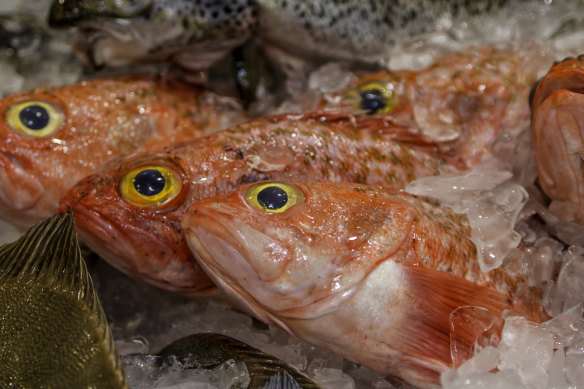By Mike Foley
The “blue tick” is marketed as a guarantee that shoppers are buying sustainably harvested seafood, but conservationists are challenging a recent decision on the slow-growing orange roughy.
The deep-sea fish, found around the southern half of the continent, reaches breeding age at about 40 years and lives up to 250 years – making them particularly vulnerable to overfishing.

Slow-growing orange roughy are found around the southern half of the continent.Credit: iStock
The fish was commercially harvested in such numbers in the 1990s that populations nearly collapsed. The federal government’s endangered species register listed orange roughy as a conservation-dependent species in 2006.
Fishing was scaled back and populations have been showing signs of recovery.
But fishing is now permitted in six locations in Commonwealth waters.
Last year, the South East Trawl Fishing Industry Association applied to the international Marine Stewardship Council (MSC) to give its blue tick of sustainability to orange roughy landed in one of those areas – the eastern trawl zone off the east coast of Tasmania.
The stewardship council is a non-profit organisation that relies on private providers to conduct independent assessments. In this case, US-based consulting and auditing firm MRAG Americas was contracted by the association to assess the eastern orange roughy fishery.
Based on MRAG’s assessment, the stewardship council has certified the fishery with its blue tick.
However, there is a window to appeal the decision and the Australian Marine Conservation Society has objected, arguing the eastern fishery is neither sustainable nor healthy.
Adrian Meder, the society’s sustainable seafood program manager, said MRAG’s blue tick recommendation relied on assumptions and contradictions.
CSIRO studies have found that fish in the eastern zone are genetically identical to those in the southern zone – hundreds of kilometres away – which Meder said showed the populations migrated and mixed.
The southern zone fishery is classified as overfished and Meder said it was likely that fishing in the eastern zone would harm the more at-risk southern population.
As a result, MRAG should have erred on the side of caution, he said.
“We invite the MSC to focus on certifying the fisheries that don’t and have never put anything on our endangered species list,” Meder said.
“There’s a multitude of Australian fisheries more sustainable than orange roughy under this simple metric.”
South East Trawl Fishing Industry Association executive officer Simon Boag dismissed Meder’s claims and said catch limits safeguarded the overall fish stock.
“The sustainable eastern zone catch has been set very conservatively and is split across the two stocks. There is very little catch in the south,” he said.
Boag said a CSIRO survey had found the eastern zone population of orange roughy exceeded 50,000 tonnes and catch limits represented a small portion of this total.
An MSC spokesperson said its assessment process was rigorous and fisheries that applied for a blue tick must demonstrate they did not compromise the long-term health of fish stocks.
“As part of the MSC’s commitment to impartiality in the assessment process, the MSC cannot comment on fishery performance while the Australian orange roughy is under assessment review,” the spokesperson said.
An MRAG spokesperson said the company welcomed dialogue with stakeholders as part of the transparent certification process.
The CSIRO, which conducts scientific stock assessments, recommended a sustainable catch limit of 633 tonnes a year in the eastern zone in its most recent report, in 2021.
The Australian Fisheries Management Authority has set the total allowable catch for the southern zone at 98 tonnes for the year to July 2025, and 879 tonnes for the eastern zone.
However, the eastern zone is the only Commonwealth fishery with a 100 per cent under-catch provision, which allows the unharvested quota from the previous year to be landed on top of the current year’s harvest. With carryover, 1325 tonnes can be caught in the 2024-25 season.
Cut through the noise of federal politics with news, views and expert analysis. Subscribers can sign up to our weekly Inside Politics newsletter.